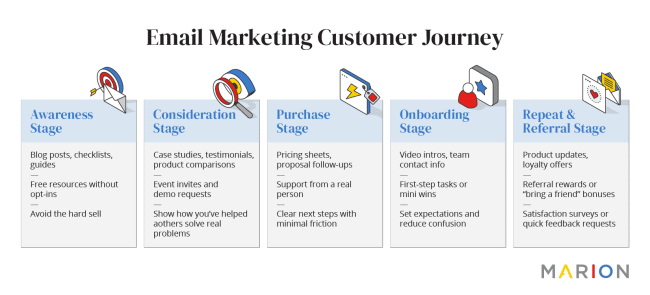When the temperature rises and inboxes get flooded, most emails go unread. Not because people don’t check their emails, but because what lands in their inbox doesn’t match where they are in their decision-making process.
That’s why you need a well-built email marketing customer journey.
So don’t just write more emails, write better ones…emails that land at the right time, say the right thing, and make people feel like your business gets what they need.
What is the Email Marketing Customer Journey?
The email marketing customer journey is the path your leads and customers take, from first touch to long-term loyalty, all through email communication. Think of it as a chain of conversations, each one with a purpose, each one building trust.
It’s not a funnel. It’s not a drip campaign you set and forget. It’s a sequence of relevant touchpoints that respond to behavior and guide the reader without feeling like a sales pitch.
Step 1: Break the Journey into Stages
Mapping your email marketing customer journey starts with understanding where your audience is mentally and emotionally. These are the five core stages to build around:
1. Awareness
This is the introduction. They don’t know who you are or what you offer.
Email Example:
- “Top 5 Costly Mistakes in [Industry] and How to Avoid Them”
- “2025 Trends You Shouldn’t Miss in [Sector]”
2. Consideration
They’re weighing options and comparing solutions. They might be reading case studies or asking around.
Email Example:
- “How [Client Name] Cut Downtime by 38% in 3 Months”
- “Webinar Invite: Choosing the Right [Service/Product] Partner”
3. Purchase
This is your chance to help them take action. They’re nearly ready to buy.
Email Example:
- “Limited-Time Offer: Get Started with No Setup Fee”
4. Onboarding
The deal’s closed but the journey’s not done. Now’s your chance to make a strong first impression.
Email Example:
- “Welcome to [Your Company Name] – Here’s What to Expect”
5. Repeat & Referral
You’ve earned their trust. Now make it easy for them to return (or refer others).
Email Example:
- “Here’s What’s New Since You Last Checked In”
- “Know Someone Who Needs [What You Do]? Share and Save.”

Step 2: Match Your Content to the Stage
Each stage of the email marketing customer journey deserves its own message, tone, and content. A strong lead magnet (something like a checklist, industry guide, or free resource) can set the right tone from day one.
Here’s how to align what you send with what your audience actually wants to see:
Awareness Stage
- Blog posts, checklists, guides
- Free resources without opt-ins
- Avoid the hard sell
Consideration Stage
- Case studies, testimonials, product comparisons
- Event invites and demo requests
- Show how you’ve helped others solve real problems
Purchase Stage
- Pricing sheets, proposal follow-ups
- Support from a real person
- Clear next steps with minimal friction
Onboarding Stage
- Video intros, team contact info
- First-step tasks or mini wins
- Set expectations and reduce confusion
Repeat & Referral Stage
- Product updates, loyalty offers
- Referral rewards or “bring a friend” bonuses
- Satisfaction surveys or quick feedback requests
Expert Tip: Don’t write for your product. Write for the questions people are asking in their head at that moment.
Need help creating lead magnets, ebooks, or case studies that attract qualified leads? MARION offers content marketing services tailored to each stage of your customer journey.
Step 3: Use Behavior to Trigger the Right Messages
Send emails based on what your audience is actually doing (not what you assume they’re ready for).
Set Triggers Like:
- Signing up for a newsletter
- Viewing a pricing page
- Downloading a guide
- Attending a webinar
For example, if someone clicks a link to view your pricing but doesn’t reach out, send a follow-up: “Still have questions about pricing? Here’s a breakdown + who to contact.”
Timing Matters
Send too many emails too fast and you’ll lose trust. Wait too long and the opportunity passes.
Space your messages based on behavior and urgency, not a pre-set calendar.
Pro Tip: Automate workflows but keep the tone personal. Use names, ask questions, and make replies feel welcome.
Step 4: Measure and Adjust Often
Track the usual metrics (opens, clicks, unsubscribes) but don’t stop there.
What Really Matters:
- How many people reply
- How many convert to calls, demos, or purchases
- How many move from one stage to the next
Test subject lines. Watch where people drop off. Cut the dead weight and double down on what works.
Fun fact: Personalized email messages improve click-through rates by 14% and conversions by 10%.

Common Gaps (and How to Fix Them)
Most companies miss the mark in a few areas. Here’s where things fall apart (and how to fix them):
1. No Welcome Series
That first impression sets the tone. A welcome email should:
- Confirm what they signed up for
- Deliver immediate value
- Introduce your brand tone and personality
2. No Follow-Up After Quotes or Proposals
If they asked for pricing and you don’t follow up, that’s a missed chance. Send a brief message that adds clarity, not pressure.
3. No Re-Engagement for Cold Leads
Someone goes quiet after a few emails? Send a soft check-in like:
- “Still exploring options? Here’s something you might find helpful.”
4. No Post-Sale Touchpoints
The sale is only the middle. A simple follow-up to ask how things are going or to share what’s next can lead to longer relationships and referrals.
Fixing the above gaps often starts with better strategy. MARION provides email marketing audits and campaign planning for businesses ready to tighten up their follow-through.
Ready to Build a Smarter Email Marketing Customer Journey?
Most email marketing falls short because it’s out of sync with what people actually need. Timing, tone, and clarity matter more than volume.
At MARION, we help businesses plan and execute email strategies that do more than hit inboxes. We create email marketing customer journeys that match how your audience thinks and moves…from first contact to loyal customer. Our marketing agency team can work with you to map out the exact touchpoints your leads need, create content that feels personal, and set up the automation that keeps it all running without feeling robotic.
If it feels like a chore to write, it’s probably a chore to read…we help you avoid that.
Let’s talk about what your next step should look like!
